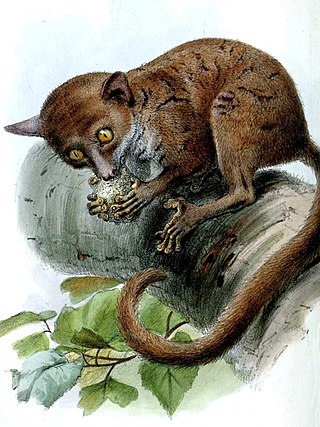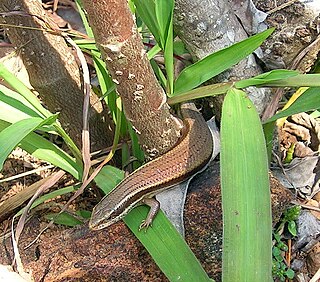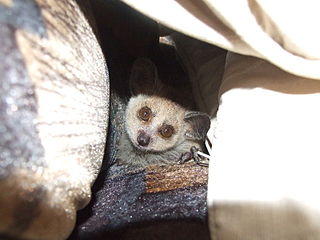
Skinks are lizards belonging to the family Scincidae, a family in the infraorder Scincomorpha. With more than 1,500 described species across 100 different taxonomic genera, the family Scincidae is one of the most diverse families of lizards. Skinks are characterized by their smaller legs in comparison to typical lizards and are found in different habitats except arctic and subarctic regions.
Melanoseps is a genus of lizards, known commonly as limbless skinks, in the family Scincidae. The genus is endemic to Sub-Saharan Africa.
Carinascincus palfreymani, known commonly as the Pedra Branca skink, as well as the Palfreyman's window-eyed skink, the Pedra Branca cool-skink, or the red-throated skink, is a species of skink in the family Scincidae. The species is endemic to Australia, and is restricted to the windswept Pedra Branca, an island off southern Tasmania of only 2.5 ha, where it is dependent on the seabird colonies. It is the only lizard species found on the island.

The western dwarf galagos are a group of three species of strepsirrhine primates, native to western and central Africa. They are classified in the genus Galagoides of the family Galagidae. The eastern dwarf galagos have been moved to their own genus, Paragalago, based on genetic evidence and differences in vocalization. The two genera are not sister taxa and thus may have evolved their small sizes via parallel evolution. They are separated by the East African Rift.

The Rondo dwarf galago or Rondo bushbaby is a species of primate in the family Galagidae. The dwarf galagos are the smallest members of the genus Galagoides. It weighs less than 100 grams, making it the smallest known galago. It is endemic to Tanzania where its natural habitat is subtropical or tropical dry forests. It lives in an area reported in 2012 to be less than 100 square kilometers and is threatened by habitat loss due to logging. While it was discovered in the 1950s, the Rondo dwarf galago was deemed data deficient until 1996. In 1996, the Rondo bushbaby was fully described as a species. It is now listed as one of "The World's 25 Most Endangered Primates." In 2010, it was also added to the Zoological Society of London's list of genetically distinct and endangered mammals.

Lygosominae is the largest subfamily of skinks in the family Scincidae. The subfamily can be divided into a number of genus groups. If the rarely used taxonomic rank of infrafamily is employed, the genus groups would be designated as such, but such a move would require a formal description according to the ICZN standards.

Scincinae is a subfamily of lizards. The subfamily contains 33 genera, and the genera contain a combined total of 284 species, commonly called skinks. The systematics is at times controversial. The group is probably paraphyletic. It is one of three subfamilies of the family Scincidae, the other two being Acontinae and Lygosominae.

The Southern Zanzibar–Inhambane coastal forest mosaic, also known as the Southern Swahili coastal forests and woodlands, is a tropical moist broadleaf forest ecoregion of eastern Africa. It is a southern variation of Northern Zanzibar-Inhambane coastal forest mosaic. The ecoregion supports habitats of forest, savanna and swamps. The southern portion of the ecoregion is not as well studied due to the 1977-1992 civil war in Mozambique.
The Rondo worm snake is a species of snake in the Typhlopidae family.
The Nchingidi worm lizard is a species of amphisbaenian in the family Amphisbaenidae. The species is endemic to Tanzania.

The eastern dwarf galagos are a group of seven species of strepsirrhine primates of the family Galagidae, native to East Africa. They were formerly classified in the genus Galagoides but have been moved to their own genus, Paragalago, based on genetic evidence, and supported by differences in vocalizations and morphology. The three western/Congolian species remain in Galagoides. The most recently discovered species, the Rungwe dwarf galago, has yet to be formally named and described.

The black limbless skink is an extant species of skink, a lizard in the family Scincidae. The species is found in Mozambique, Malawi, Zambia, Kenya, Tanzania, and Democratic Republic of the Congo.
The Uluguru limbless skink is an extant species of skink, a lizard in the family Scincidae. The species is found in Tanzania.
The Pangani black limbless skink or longtail limbless skink is an extant species of skink, a lizard in the family Scincidae. The species is found in Tanzania.
Loveridge's limbless skink is an extant species of skink, a lizard in the family Scincidae. The species is found in Tanzania and Zambia.
The western limbless skink is an extant species of skink, a lizard in the family Scincidae. The species is found in Cameroon, Equatorial Guinea, Gabon, Democratic Republic of the Congo, Angola, and Central African Republic.
The pygmy limbless skink is an extant species of skink, a lizard in the family Scincidae. The species is found in Tanzania.
The Udzungwa limbless skink is an extant species of skink, a lizard in the family Scincidae. The species is found in Tanzania.
Scolecoseps acontias, also known commonly as the sandy limbless skink, is a species of lizard in the family Scincidae. The species is endemic to Tanzania.







